Introduction: Gena Philibert-Ortega is a genealogist and author of the book “From the Family Kitchen.” In this blog article, Gena searches old newspapers to learn more about an effort on the American home front during World War II to support the country and the troops: the planting of “Victory Gardens.”
What was your family doing during World War II? Often we remember the brave American soldiers who went “over there” and fought for freedom, but forget that those left behind on the home front were an integral part of the war effort. Families in the United States did their part by buying WWII war bonds, recycling metals, and participating in the rationing of food and other materials.
In order to supplement the rationed food they could purchase during WWII, families cultivated Victory Gardens that supplied them with fresh homegrown produce – both in the short term as well over time as they learned to preserve their harvest. This increased food production also freed up more canned food for sending to the soldiers overseas.
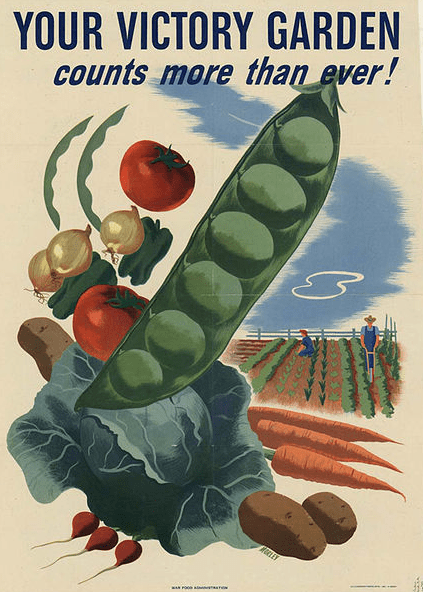
It might seem that learning more about your ancestors’ WWII Victory Garden would be near to impossible. After all, unless you have a diary, photos, or an interview with a family member, how would you learn more?
[search_box]
The answer: a collection of online newspapers, such as GenealogyBank’s Historical Newspaper Archives, is a great go-to place to uncover the lives of everyday people. World War II-era newspapers don’t disappoint, with articles and mentions of men, women, and children living during the war. A search for your ancestors or browsing their hometown newspaper can provide many interesting Victory Garden finds.
Victory Garden Poems & Essays
Many gardeners waxed poetic about the Victory Gardens they were growing or were planning. Adults and children alike submitted their garden poetry to newspapers. Many of these were titled, not surprisingly, “My Victory Garden.” Poetry contests at this time were full of patriotic, instructive poems encouraging everyone to do their duty.
In this example found on the “Junior” page of the Daily Illinois State Journal, 14-year-old Alice Mae Jackson of Carlinville encourages other teens to grow a garden during the summer:
Why don’t you garden a little instead of play
And help to pass your spare time away?
Also, you’ll find, some of these days
Your Victory garden really pays
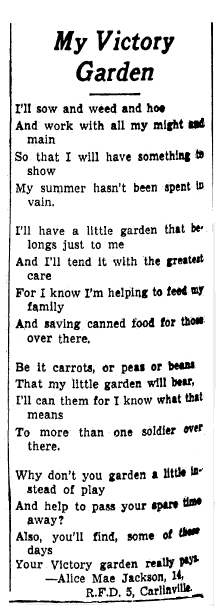
Young people didn’t just write poems about Victory Gardens; they also entered contests describing the gardens they planned on planting. In this winning entry from the Jordan Marsh Victory Garden Contest, Eva Solimine of Belmont, Massachusetts, won $5 for her entry that stresses the importance of these wartime gardens. She writes:
We all have a job to do, and it is everybody’s job [planting a garden]. Our men are fighting on the battlefronts, and also men and women are working in defense plants making ships, tanks and other weapons to win this war. We at home also have a job to do, and that is by buying War Saving Stamps and Bonds and by planting Victory Gardens this summer and every other summer until this war is won.
Her essay points out the shortage of food during World War II and how homegrown gardens allow more food to be sent to soldiers.
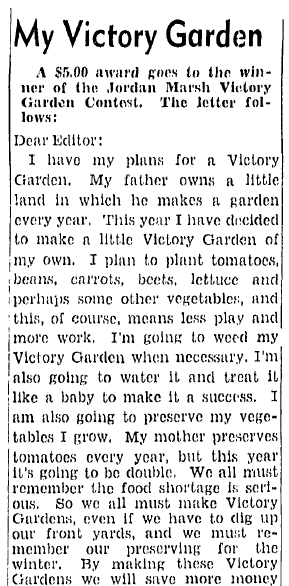
Victory Garden Seed Advertisements
There’s no doubt that Victory Gardens were a great marketing tool for nurseries and seed suppliers. Just like other newspaper advertisements we’ve discussed in previous articles (see links at the end of this article), they sometimes used real people to provide endorsements – complete with a photo and home address. This advertisement from Germain’s Seeds is just one of many that can be found with a community member’s photo. In this ad featuring Mrs. Dorothy Hoelsken from Oakland, California, she testifies that:
I have planted Germain’s Seeds exclusively the last two years, and my Victory Garden has been the talk of the neighborhood.
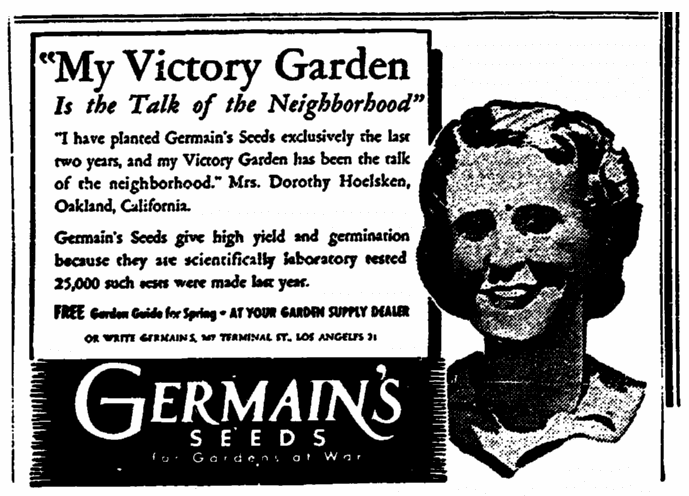
Further genealogical research shows that Mrs. Hoelsken lived in the Bay Area of California for a number of years, up to her death in 2000. The advertisement’s mention of Mrs. Hoelsken’s residence allows a researcher to continue searching for her in records such as city directories.
Mrs. Hoelsken wasn’t the only person featured in ads for Germain’s Seeds. Mrs. Mary Hammons of Merced, California, is quoted and pictured in another ad along with the tag line “Seeds for Gardens at War.” This is a good example of how our ancestors and their image can appear in just about any part of the newspaper.
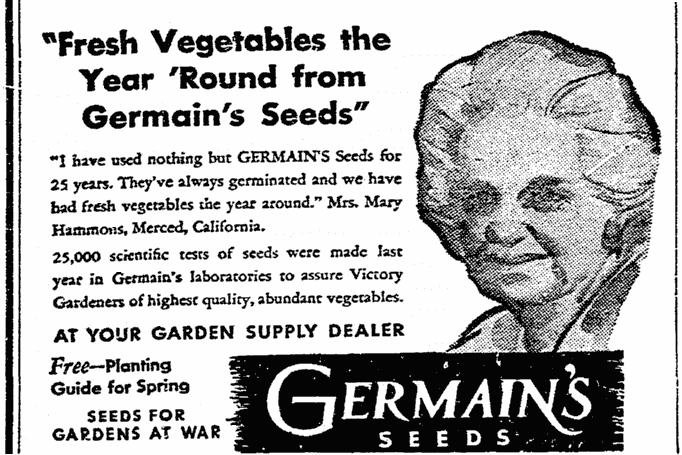
Victory Garden Letters
Newspapers provide various opportunities to express an opinion, tell a story or ask a question. One of these opportunities is to write a letter either to the editor or to an advice column. During the war we find people asking questions about gardening and sharing experiences. In this, somewhat funny example sent to the editor of the Sacramento Bee in July 1943, the writer may have seen ants as a valuable help and less of a hindrance in his Victory Garden.
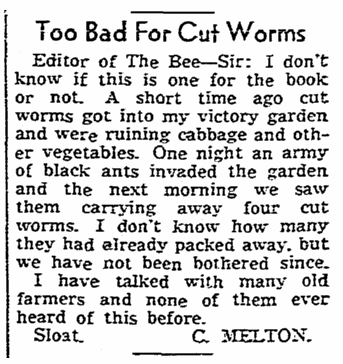
A cutworm is actually a caterpillar who feeds at night, attacking the stem of a plant by “cutting” it down.
Some newspaper columnists used readers’ comments in their columns, as in this Illinois example from “Uncle Ray” where reader Mr. J. A. Ibbotson remarks on his experience with the English berry bushes in his Victory Garden.
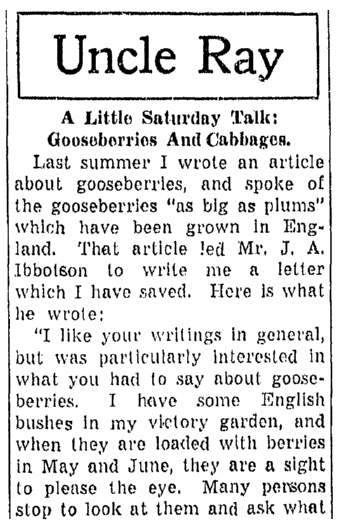
And of course there were newspaper columnists who answered questions about Victory Gardens, as in this 1943 example from Springfield, Massachusetts. This type of old newspaper column is a good example of being creative with searching on your ancestor’s name. Rarely in these types of historical articles do you see the entire name of those who provided the questions. Often they are simply identified by initials, or a first name and initials.
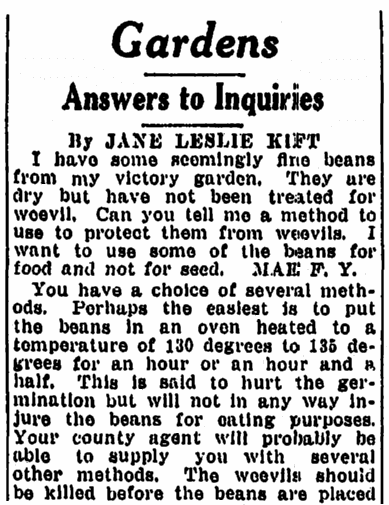
Did your family grow a Victory Garden during World War II? There’s a good chance they did – and that effort may be found in articles from their hometown newspaper. Dig into GenealogyBank’s Historical Newspaper Archives and see if you can find their stories.
Related Articles:
- Rationing Thanksgiving Dinner during World War I
- The Importance of Old Newspaper Advertisements to Genealogy
- Our Ancestors’ Stories Live in Old Newspaper Ads Too
- Old Classified & Personal Ads Reveal Our Ancestors’ Love Lives
- Women during World War II: Knitting & Sewing on the Home Front
- Little-Known WWII Facts: German POWs in the U.S.
[bottom_post_ad]

In Compton, California, our family dug up the front yard lawn and planted string beans, tomatoes, Swiss Chard, carrots and potatoes. Root vegetables did not do well for us as the wireworms enjoyed them before we pulled them up. Tomato worms were gorgeous, but we had to eliminate them in order to have a crop for ourselves.
Thank you so much for sharing that Margaret. What wonderful memories!
With the drought conditions and the rationing of water here in California, people are starting to dig up their front lawns to use that space for something else. Maybe we’ll see front yard vegetable gardens again!